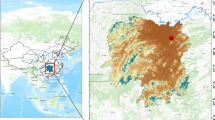Abstract
The effect of heat treatment and the layer orientation on the tensile properties of granitic gneiss were studied under the unconfined stress condition. The tensile strength of the samples was studied using a Brazilian configuration, and the geochemical and microstructural properties were studied using the X-ray diffraction technique as well as scanning electron microscopy (SEM), respectively. The fracture pattern and the geometrical analyses were performed using the digital photographs. The results show that both the heat treatment and layer orientation have strong control on the tensile strength, force-parallel and layer-parallel strains, and on the tensile fracture geometry. A general decrease in the tensile strength of the rock was documented with the increasing heat treatment. Although, in the heat-treated samples, X-ray diffraction study do not reveal any major change in the mineral composition, but the SEM shows the development of several micro-cracks in the grains. In the samples with different layer orientation, along with the changes in the tensile strength and layer-parallel to force-parallel strain ratio, the layer activation under shear stress is also noticed. Here, the ratio between the tensile to shear stress, acting along the layers is thought to be the major controlling factor of the tensile properties of rocks, which has many applications in mining, civil constructions, and waste disposal work.


















Similar content being viewed by others
References
Amadei F (1996) Importance of anisotropy when estimating and measuring in situ stresses in rock. Int J Rock Mech Min 33:293–325
ASTM D3967–08 (2008) Standard test method for splitting tensile strength on intact rock core specimens. ASTM International, West Conshohocken, PA. doi:10.1520/D3967-08
Bauer SJ, Johnson B. (1979) Effects of slow uniform heating on the physical properties of the Westerly and Charcoal granites. In: Proceedings of 20th symposium on rock mechanics Austin, Texas: ASCE, New York, pp 7–18
Chen YL, Ni J, Shao W, Azzam R (2012) Experimental study on the influence of temperature on the mechanical properties of granite under uni-axial compression and fatigue loading. Int J Rock Mech Min 56:62–66
Dan DQ, Konietzky H, Herbst M (2013) Brazilian tensile strength tests on some anisotropic rocks. Int J Rock Mech Min 58:1–7
Dwivedi RD, Goel RK, Prasad VVR, Sinha A (2008) Thermo-mechanical properties of Indian and other granites. Int J Rock Mech Min 45:303–315
Gautam PK, Verma AK, Maheshwar S, Singh TN (2015) Thermomechanical analysis of different types of sandstone at elevated temperature. Rock Mech Rock Eng. doi:10.1007/s00603-015-0797-8
Heuze FE (1983) High-temperature mechanical, physical and thermal properties of granitic rocks—a review. Int J Rock Mech Min 20(1):3–10
Homand-Etienne F, Houpert R (1989) Thermally induced microcracking granites: characterization and analysis. Int J Rock Mech Min 26(2):125–134
Homand-Etienne F, Troalen JP (1984) Behaviour of granites and limestones subjected to slow homogenous temperature change. Eng Geol 20:219–233
Liu S, Xu J (2014) Mechanical properties of Qinling biotite granite after high temperature treatment. Int J Rock Mech Min 71:188–193
Paquet J, François P (1980) Experimental deformation of partially melted granitic rocks at 600–900 C and 250 MPa confining pressure. Tectonophysics 68(1–2):131–146
Shao S, Ranjith PG, Wasantha PLP, Chen BK (2015) Experimental and numerical studies on the mechanical behavior of Australian Strathbogie granite at high temperatures: an application to geothermal energy. Geothermics 54:96–108
Sharma Y, Singh TN (2010) A new technique for porosity estimation using seismic density. Petroview III(3):3–12
Szwedzicki T (2007) A hypothesis on modes of failure of rock samples tested in uniaxial compression. Rock Mech Rock Eng 40(1):97–104
Tavallali A, Vervoort A (2010) Effect of layer orientation on the failure of layered sandstone under Brazilian test conditions. Int J Rock Mech Min 47:313–322
Tavallali A, Vervoort A (2013) Behaviour of layered sandstone under Brazilian test conditions layer orientation and shape effects. J Rock Mech Geotech Eng 5:366–377
Vervoort A, Min K, Konietzky H, Cho J, Debecker B, Dinh Q, Frühwirt T, Tavallali A (2014) Failure of transversely isotropic rock under Brazilian test condition. Int J Rock Mech Min 70:343–352
Vishal V, Pradhan SP, Singh TN (2011) Tensile strength of rock under elevated temperature. Geotech Geol Eng 29:1127–1133
Wisetsaen S, Walsri C, Fuenkajorn K (2015) Effects of loading rate and temperature on tensile strength and deformation of rock salt. Int J Rock Mech Min 73:10–14
Wong TF (1982) Effects of temperature and pressure on failure and post-failure behaviour of Weterly granite. Mech Mater 1:3–17
Xu X, Gao F, Shen X, Xie H (2008) Mechanical characteristics and microcosmic mechanism of granite under temperature loads. J China Univ Min Tech 18:413–417
Zhao Z (2015) Thermal influence on mechanical properties of granite: a micromechanical perspective. Rock Mech Rock Eng. doi:10.1007/s00603-015-0767-1
Acknowledgments
The authors would like to acknowledge the generous help extended by Mr. Rajesh Singh, Mr. Tushar Gupta and Mr. Nikhil Sirdesai during various stages of Brazilian tensile test experiments and manuscript preparation. The anonymous reviewer is thanked for his positive criticisms that helped to improve the quality of the manuscript.
Author information
Authors and Affiliations
Corresponding author
Rights and permissions
About this article
Cite this article
Guha Roy, D., Singh, T.N. Effect of Heat Treatment and Layer Orientation on the Tensile Strength of a Crystalline Rock Under Brazilian Test Condition. Rock Mech Rock Eng 49, 1663–1677 (2016). https://doi.org/10.1007/s00603-015-0891-y
Received:
Accepted:
Published:
Issue Date:
DOI: https://doi.org/10.1007/s00603-015-0891-y




